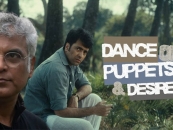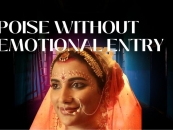_(1)-853X543.jpg)
A Quart of Ray
by Shantanu Ray Chaudhuri June 29 2021, 12:00 am Estimated Reading Time: 12 mins, 12 secsEver since Satyajit Ray passed away, his works have made it to the screen in sterile, ineffectual adaptations. Netflix’s Ray corrects that anomaly, writes Shantanu Ray Chaudhuri.
Three intrepid filmmakers give four stories of the master their own vivid interpretations. In the process, the anthology goes beyond being just a banal introduction to the fiction of the master filmmaker
In his 1964 essay ‘On Charulata’ (Speaking of Films/Bengali title ‘Charulata Proshonge’ in Bishoy Chalachitra), Satyajit Ray takes on one Mr Rudra who, in ‘the October issue of Parichay’, has the temerity to question Ray’s adaptation of Charulata. Ray quotes Mr Rudra as saying, ‘The similarity that Mr Ray’s Charulata bears to Tagore’s Nastaneer is the same as the similarity it bears to thousands of other stories in the world. Was there any problem in keeping the story completely unchanged when the screenplay was written?’
Ray responds, rather uncharitably: ‘In the case of cinema, I often find that anyone who has seen Sangam will also peer into a screening of La Dolce Vita. If every Tom, Dick and Harry starts to reveal his little and, therefore, dangerous knowledge in journals and magazines, will it not create confusion in the minds of readers and viewers who have only recently started displaying signs of being able to distinguish between good and bad films?’
Before going on to provide a masterclass on adaptations, Ray is brutally dismissive of Mr Rudra’s criticism: ‘I do not know if Mr Rudra understands anything of literature. Of films he understands nothing. It [is] apparent that he needs to be taught the basic a-b-c of scriptwriting.’
I was reminded of this not only while watching Netflix’s new series Ray, but also reading the reviews it has garnered, both critics’ and general viewers’, most of them rather unflattering, quite a few uninformed and often needlessly vitriolic. Ray himself was quite liberal in making changes to an original text while adapting it for the screen (Charulata, the Apu Trilogy, and even his adaptation of his own novel Sonar Kella, where, keeping in mind the difficulties associated with filming a detective novel, he changed the structure of the film from a whodunit to a howdunit).
_(1).jpg)
Interestingly enough, the one adaptation in which Ray took almost no liberties with the original (apart from updating the era) turned out to be his weakest film, Ganashatru (1989), marked by verbosity and staginess that never breaks free of the origins of Ibsen’s play. Unfortunately, most reworking of his stories on screen that came after him (almost without exception scripted and directed by Sandip Ray) - the Feluda films, Sandip Ray’s barren adaptations in the anthology films Char and Jekhane Bhooter Bhoy, or Professor Shonku O El Dorado - suffer from too much reverence for the original.
Take, for example, the classic ‘ghost’ story ‘Anath Babu’s Terror’. While the story masterfully creates the mood and unease of a man’s obsession with haunted houses, the film - part of the anthology Jekhane Bhooter Bhoy - merely reproduces the conversations in the story with no visual imagination whatsoever, so that the final twist, which gives you goosebumps while reading, is rendered flat and ineffectual in the film. Similarly the ‘magic’ of a Shonku story, which always left a lot to the reader’s imagination, never quite translates to the screen in Professor Shonku O El Dorado, failing miserably in breaking free of the text, so much so that watching the film is almost like reading the story on paper, which defeats the purpose of a film.
That is why Ray, despite its little flaws, is important. In the hands of filmmakers Srijit Mukherji, Abhishek Chaubey and Vasan Bala, along with the writers Niren Bhatt and Siraj Ahmed, these four stories by the master get a life all their own. I remember Gulzar-ji once telling me vis-à-vis Vishal Bhardwaj’s adaptations of Shakespeare: ‘If you were not told that they originated from Shakespeare, you wouldn’t know.’ These filmmakers take the kernel of the idea from Ray’s original stories and create something altogether different, something that if you were not told you probably wouldn’t have known originated with Satyajit Ray.
_(2).jpg)
Take Srijit’s featurettes ‘Forget Me Not’ and ‘Behrupiya’ - probably the two most difficult adaptations in the anthology primarily because of the world in which the originals exist and the creative choices the director makes with his take.
The first paragraph of ‘Bipin Chowdhury’s Smritibhrom’, which inspired ‘Forget Me Not’, describes Bipin Chowdhury: ‘He lived alone, was not a good mixer, had few friends and didn’t like spending time in idle chat.’ In those few words you have the prototype of a Satyajit Ray protagonist across most of his stories. Srijit’s vision upends that solitary man into an egotist, self-obsessed (bordering on arrogant), selfish prick, a high-flying entrepreneur surrounded by loving friends, family and colleagues. Writer Siraj Ahmed also changes the rather harmless prank of the original into a more sinister tale of revenge. These two major creative decisions then drive the film’s visual flair or what many reviewers have seen as a ‘lack of nuance’. The world of Bipin Chowdhury is nuanced, understated; Ipsit Nair’s corporate avatar is not.
And the director and cinematographer (Swapnil S. Sonawane) create the off-kilter world, right from that glittering rooftop bar where it begins to that unsettling scene by the pool where Ipsit finally comes unhinged and the masterly climactic sequence at Ajanta Caves and after - my only crib is the rather lengthy explanation at the end, which the filmmakers could have left to the viewer’s imagination because it does come through in flashes in the narrative. And as for the reviewers who have objected to the profusion of cuss words, well really? Step out on to the streets or into the corridors of a swanky corporate office, literally every sentence you hear is littered with the ‘F’ word, or its Hindi equivalent, which has almost become what a character in Abhishek Chaubey’s ‘Hungama Kyon Hai Barpa’ would call a takiya-kalam.
_(2).jpg)
In ‘Behrupiya’ too Srijit takes a risky creative call to alter the benevolent whimsy of the original into an edgy exploration of the darkness at the core of the human heart. Nikunj, the innocuous protagonist in the original, a salesman in a College Street bookshop who comes into an inheritance and is free to pursue his new interest in make-up and disguise, becomes Indrashish, a timid, self-effacing makeup artist devoid of self-esteem, perpetually being put down by the woman he loves, his boss at work, his landlord. So, when he inherits a book on make-up from his grandmother, he decides to put that to use, metamorphosing from Dr Jekyll to Mr Hyde, wreaking havoc on his tormentors.
While in the original, the emphasis is on the protagonist having some innocent fun with his new passion, it is entirely to the director and writer’s credit here that Indrashish’s obsession leaves you uneasy. His belief in his infallibility and his efforts to play God hit a wall when he comes across a holy man, Peer Baba. In another drastic departure from the original, where the encounter with the god-man is played largely for laughs, here it becomes a battle of wits between the two (Srijit’s lensing here conveys the outlandish nature of the face-off), ultimately driving Indrashish over the edge as his mask literally becomes his face in a macabre ending.
Few people do the dark and twisted thriller as well as Srijit (the uninitiated could also explore his interest in prosthetics and make-up as evidenced in his films Vinci Da and Gumnaami), and it is obvious that he is in his element here with the narrative, the production design, the over-the-top colour scheme (which admirably convey the POV of a man losing his mind in the throes of a fixation). More importantly, he succeeds in communicating his relish to the viewer.
_(2).jpg)
There’s a reason why Abhishek Chaubey’s ‘Hungama Kyon Hai Barpa’ could emerge as the most audience pleasing of the four adaptations here. It is also the one that takes the least amount of liberties with the structure of the original, ‘Barin Bhowmik-er Byaram’. (Though that doesn’t stop viewers from objecting to even ‘Hungama Kyon Hai Barpa’ as the title of a Ray story.) A well-known singer, Barin, travelling by train to a concert, meets a stranger who seems vaguely familiar. Over the course of the journey, Barin recognizes the man and is forced to own up to a shameful ailment that afflicted him in the past.
Abhishek’s major achievement lies in the way he adapts the original, which takes place largely in the mind of narrator-protagonist Barin, and makes for a riveting drama played within the confines of a train. However, what is likely to get viewers rooting for this most is its mellifluous language, as writer Niren Bhatt changes Barin to Musafir Ali, thus paving the way for Abhishek to call upon his Ishqiya days and create magic with Urdu.
From the first sequence where he meets a fan who asks him if he is Musafir Ali and he responds with Ghalib’s ‘Poochte hai woh ke Ghalib kaun hai’, before going on to hum Ghulam Ali ‘Yeh dil yeh pagal dil mera’ under his breath, ‘Hungama’ is delightful, even when it plays to the gallery with its chaste Urdu. Equally fun is the character Musafir meets on the journey, Aslam Baig - Jenga pehelwan, Rustam-e-Patparganj, Karkardooma kesari - who addresses Musafir as ‘cassette waley’ and while describing himself as a fan of the singer, mispronounces maikhana as paikhana (to be very politely corrected by the singer) and wonders if Ghulam Ali was a Pakistani fast bowler with a deadly outswinger.
To top it all, there’s the memorable climax at the delectably named shop Rooh Safa, which aims to cleanse the soul of man, and which has a delightful meta reference to Satyajit Ray! But Abhishek is too good a director to let the language get the better of the narrative. There’s great visual flourish at work here too, bringing out the anguish of Musafir Ali’s past and the origins of his ailment - ki-le-pato-maaniya, as the elderly hakim tells him - through brilliantly executed transitions so that one never realizes that the entire film is confined indoors to a train compartment.
_(1).jpg)
Of the four stories, it is ‘Spotlight’ that veers the most from the original, entirely doing away with what constituted its core - a meeting with a man who claims to be 126 years old. The star in the original is at best a marginal character mentioned in passing by the family holidaying at Chhota Nagpur, who decide that a meeting with a man who has met Tagore would be more interesting than a superstar. In Vasan Bala’s adaptation, the star, ‘one-look’ Vikram, is in the limelight, increasingly disconcerted by the spotlight shifting from him to a god-woman, Didi (who never existed in the original), ‘one look from whom can change the universe’.
The writer Niren Bhatt has a few amusing lines, including Vik’s friend and manager’s take on cinema vis-à-vis religion, Vik’s existential question ‘am I a sea or a puddle’ or his exchange with his girlfriend:
Vik: This is a Kafkaesque nightmare./Anu: What is that?/Vik: I don’t know – they use the expression./(And a little later)/Vik: This is more than a Kafkaesque nightmare, it’s a Lynchian nightmare/Anu: What is that?/Vik: I don’t know - they use the expression.
However, ‘Spotlight’ never quite comes off as a whole despite a lip-smackingly unexpected and tender climactic encounter between the star and the god-woman. Vasan, whose feature Mard Ko Dard Nahin Hota was a favourite with critics (I never took to it and kept wondering what I was missing and what the hullabaloo was all about), lacks the visual flourish of Chaubey and the chutzpah of Srijit, so that despite the brave departure from the original and the incorporation of a more contemporary god-woman into the narrative, the film does not quite work. Moreover, unlike Abhishek’s in ‘Hungama…’, his reference to Ray - with a hallucinating Vik witnessing Didi invoke the whole gamut of film names from Agantuk and Paras Pathar to Nayak, Pratidwandi, Kapurush, Mahapurush and Devi - is way over the top, mirthless, with the context seeming patched on, forced and not integrated with the narrative.
The performances are consistently top-notch across the four stories, with Manoj Bajpayee and Gajraj Rao (Hungama…), Kay Kay Menon (Behrupiya) and Radhika Madan (Spotlight) in particular standing out. Ali Fazal in Forget Me Not conveys well the agony of someone whose mind is falling apart while Harshvardhan Kapoor gamely takes on the challenge of playing a petulant star with little or no talent. What’s also interesting is the array of women characters here - unlike the Ray originals, which were almost entirely devoid of any feminine characters - though even here the women are not central to the narrative, barring of course Devi in ‘Spotlight’.
Clocking in at 50 minutes to an hour each, it can be argued that the segments could have done with a few minutes less running time, but all in all the films, more ‘inspired by’ than ‘based on’, make for an enjoyable jaunt that work more than as just an introduction to Satyajit Ray. In fact, in many ways, anyone wanting to get a sense of the master’s fiction would be well advised to read them. These films stand way too independent of the original.
For all the naysayers lamenting injustice to the stories and to the legacy of Satyajit Ray, there’s the master’s own riposte to Mr Rudra with which I began this review.





-173X130.jpg)


-173X130.jpg)

-173X130.jpg)
-173X130.jpg)
